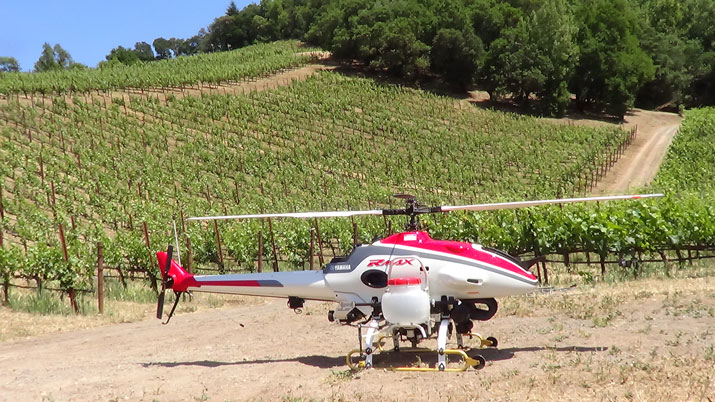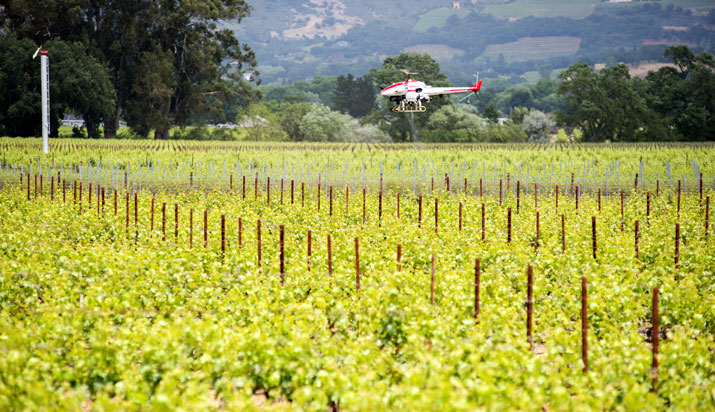
Robohub.org
Lay of the land: Unmanned systems coming to commercial agriculture

With the global market for unmanned systems in agriculture on the rise, companies that make robotic ground and air systems are paying close attention.
More than 25,000 “field” or agriculture robots will be sold by 2015 — about the same as robots for military use, according to the International Federation of Robotics. Together, defense and agriculture make up the lion’s share of the nearly 94,000 “service robots for professional use” that the IFR believes will be sold in the next couple of years. Defense and agriculture are by far the two largest categories in IFR calculations, with robots for things like logistics, medicine and rescue coming in well behind.
IFR statistics for 2011 sales of “professional use” robots — as opposed to robots for the industrial sector — offer a snapshot of this market. Overall unit sales in 2011 were up 9 percent over 2010, with unmanned systems for armies around the world coming in at 6,570, or 40 percent of the total. Right behind were sales of unmanned systems for agriculture at 5,000 units, or 31 percent.
Going Commercial
For companies like Harvest Automation, such numbers confirm that they’re on the right track. The Billerica, Mass., company was founded in 2010 to look for ways to match robotic technology with sectors that still require difficult, repetitive manual labor, says CEO John M. Kawola. Meatpacking, warehousing, construction and a host of other areas were scrutinized.
But, he says, the founders “pretty quickly honed in on agriculture,” because even though there have been significant advances in automation in “big ag” — wheat, corn and soy, for instance — “there still are large sectors of agriculture that rely heavily on manual labor.”
One is horticulture, a category of specialty crops, which, according to the U.S. Department of Agriculture, is defined as “intensively cultivated plants that are used by people for food, medicinal purposes and for aesthetic gratification.” This includes cut flowers, evergreens and bushes — “anything that is grown and sold in a container,” Kawola says. It’s “the nursery and greenhouse sector.”
But horticultural work today, “from planting to maintenance to harvesting, is being done the way it was done 20 years ago, 100 years ago.” Harvest Automation’s goal, therefore, is to use robotic technology to address material handling, harvesting, information gathering and sensing, and information management. It’s worth the effort because the wholesale horticulture market in the U.S. is huge, $17 billion. The crop value per acre is also huge — $15,000 for blueberries, for instance, compared to about $500 per acre for big ag crops like corn and wheat. In addition, it’s a much more continuous business — while big ag crops are planted and harvested once a year, horticulture crops can turn over every six weeks or so.
All this presents several possibilities to robot makers. The one initially chosen by Harvest Automation is to take the relatively easy approach of picking up and moving containers or potted plants. Its first product, the HV-100, is designed to do this job in nurseries and greenhouses. Kawola says it’s easy to operate by farm workers, and, because it’s relatively small, weighing about 80 pounds and standing two feet tall, it’s a safe working companion. He says it can work individually or in teams, depending on size of an operation. A video of several of the robots at work shows their movements to be similar to those of iRobot’s household Roomba vacuum cleaner. In fact, says Kawola, Joseph Jones, cofounder and chief technology officer of Harvest Automation, was one of the inventors of the Roomba when he was at iRobot.
Another company, Robotic Harvesting LLC of Simi Valley, Calif., has chosen to approach the market with a technically more complex system, one that harvests strawberries. The idea, says CEO Joe Wickham, is to develop a robot that can “automatically go up and down the fields picking strawberries. It’s still in the prototype phase. It’s a complex piece of machinery. It’s not something that can be done overnight, but we’re very interested in bringing this to market and getting commercial acceptance for it.” The recession slowed interest in the project and has prompted Robotic Harvesting to put it on the back burner.
Wickham acknowledges that, at least for now, people are more discerning than robots when it comes to identifying strawberries that are not fully ripe or misshapen. On the other hand, he says, advances in sensors and image processing software, “like disparity mapping and other algorithms that are useful for these types of complex vision tasks,” are making the technology more feasible. Meanwhile, Wickham says, some universities are studying the idea of developing a breed of strawberry plant that’s nearly leafless, “and the thinner the leaf canopy, the easier it is to robotically harvest the berry,” Wickham says.
Challenges For Flight
While companies like Harvest Automation and Robotic Harvesting are dealing with their own sets of challenges in agriculture, companies that want to use robot aerial systems in this market face others. One big hurdle is approval by the Federal Aviation Administration. It’s now illegal to fly unmanned aerial systems for commercial purposes in U.S. airspace. Assuming the Federal Aviation Administration approves low-level, line-of-sight operations — like those applicable to the monitoring and spraying of crops, for instance — analysts expect the market to boom. An AUVSI report in March 2013 says that during the period 2015-2025, integrating UAS into national airspace will contribute $82 billion to the U.S. economy — a whopping $75.6 billion of which will go directly to agriculture. Another $3.2 billion will boost the public safety sector, and the remaining $3.2 billion will go to the “other” category. More than 100,000 jobs would be created.
The 38-page report, “The Economic Impact of Unmanned Aircraft Systems Integration in the United States,” says unit sales of UAS will rocket from just under 40,000 in 2015 — when FAA is expected to give its approval — to about 160,000 by 2025. Even so, the study’s authors take what they say is a conservative approach, using “100,000 unit sales per year as a conservative benchmark.” One of the authors, Bijan Vasigh, a professor of transportation at Embry Riddle Aeronautical University in Daytona Beach, Fla., says the numbers could be higher, or lower. “We are really projecting what will happen in a normal scenario. If the scenario is more conducive for [unmanned aircraft], the impact would be much stronger.” At the same time, unforeseen circumstances “could impede progress.”
Some aren’t sure how the FAA will rule, but Vasigh is optimistic. “Frankly, I don’t see that much problem with FAA. I’m a little bit positive on go ahead, especially at lower altitude.”
Optimism, with a bit of caution, is also expressed by Young Kim, general manager of BOSH Precision Agriculture, Newport News, Va. BOSH, which has been oriented to the military UAS market, is shifting its sights to UAS for agriculture because the market is big and steady — as opposed to defense, which is big but probably won’t be steady forever.
“As an entrepreneur, I’m an optimist,” Kim says. At the same time, he sees no large, single, organized group engaging the FAA. “If we can get the farmer, UAV vendors, universities, economic development people, ag trade organizations,” like state cotton and peanut commissions and citrus growers, all addressing the FAA with a unified voice on safety and certification and policy, possibly with AUVSI participation, success would be more certain.
Foreign Expertise
Japan is well ahead of the U.S. in the use of unmanned aerial systems for agriculture. In 1983, the Japanese government asked Yamaha to help it develop an unmanned helicopter for agricultural duties. The country was faced with an aging farming population and wanted to make things like spraying more efficient, according to Steve Markofski, a U.S.-based new business planner for the company. In 1991, he says, Yamaha began to market its first ag-oriented unmanned helo, the R50. Today, 2,150 Yamaha RMAX unmanned helos spray about 2.5 million acres a year in Japan, covering about 40 percent of the country’s rice paddies. The government backed the idea from the beginning, with the Japanese department of agriculture responsible for regulation.

Yamaha hopes to translate its success in Japan to the U.S. One area that it thinks is promising is spraying vineyards. Yamaha is testing the idea, under a certificate of authorization from the FAA, by flying over vineyards in Napa, Calif. They’re about the same size as rice paddies in Japan, five acres or so, and therefore a good match to the RMAX’s four-gallon chemical payload capacity, Markofski says. Tractors, traditionally used in Napa vineyards, can spray about two acres an hour, but RMAX can do 12 to 15 acres an hour. And with RMAX, Markofski says, there’s no soil compaction, no crop damage, the operator is not exposed to chemicals and it is safer, because he doesn’t have to drive in challenging terrain, like slippery hills. “We’re looking at areas [in the U.S.] that we think align directly to the RMAX, and vineyards is one that jumped out at us,” Markofski says.
Canada’s MicroPilot also is waiting for a green light from the FAA. The company, based in Winnipeg, Manitoba, is a leading manufacturer of UAS autopilots as well as the maker of CropCam, a camera-toting fixed-wing UAS that has made a name for itself in crop monitoring. CropCams have been sold in places like Kazakhstan, Southeast Asia and South America, but approval to fly in the U.S. would be a big boost, says Pierre R. Pepin, vice president of sales and marketing. He says one business model might be to work with those who sell pesticides, for example. They also could sell UAS services. A customer would therefore not only get a product from the seller, but also precise images of his crops.
“Once you’re allowed to fly,” Pepin says, “it doesn’t take a whole lot of imagination to see how you can use those little birds.”
[This article first appeared in AUVSI’s Mission Critical‘s agriculture issue.]
tags: cx-Aerial, cx-Business-Finance, Environment-Agriculture, Mapping-Surveillance, robohub focus on agricultural robotics


